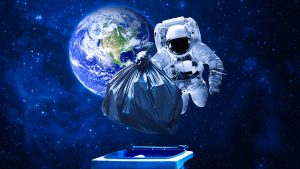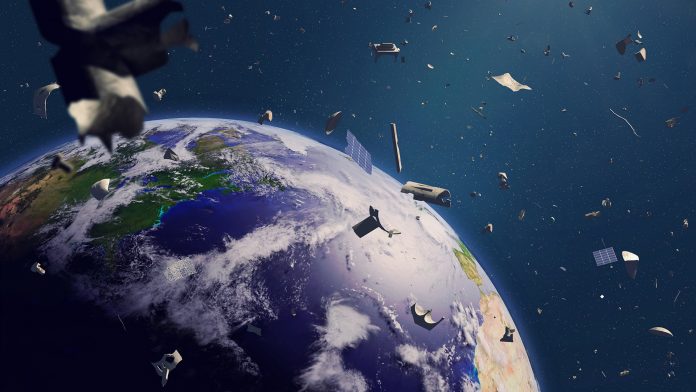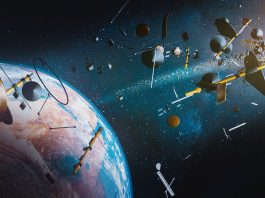Trisha Saxena, Investor at Seraphim Space, discusses how the growing space sector is addressing the issue of space debris and how this must be done sustainably.
What is space debris?
The growing space sector is now more profound than ever. Humans have been launching satellites, space probes, and themselves to space for over 60 years. Back then, nobody could have predicted that one of Earth’s currently most pressing problems – waste – would also become an issue in space.
Surely space is vast enough that there’s, well, space, for everything? Unfortunately, that’s not the case closer to home, where commercial and government space actors fight to own real estate in Earth’s orbits.
Earth has multiple orbits for satellites and spacecraft to be operated from – Low Earth Orbit, Medium Earth Orbit, Geostationary Orbit, and many others, depending on the purpose.
The growing space sector is now facing the consequences of its actions: having useful satellites in space is great until there are too many.
About 7,000 commercial and government satellites are already in space, addressing everything from earth observation for improved wildfire predictions to telecommunications for always-on connectivity.
The exponential increase of objects in space has been driven by the falling cost of launch to space, enabling many new business models to close. Some estimates suggest the number of operational satellites launched to space could quadruple in the next decade, breaching 30,000.
Space debris refers to remnants of old satellites, launch vehicles, or defunct objects that no longer serve their purpose. While not all of these tens of thousands of satellites will always remain operational, they will still stay in orbit, causing traffic jams for everyone else.
Why is space debris an issue?
NASA estimates that there are over 27,000 pieces of orbital debris, which has been tracked by the Department of Defense’s Space Surveillance Network.
However, there are guaranteed to be many more, as this number refers to those larger than a baseball. It is expected that there are hundreds of millions which are smaller than a millimetre across. Smaller-sized debris isn’t any less dangerous. Tiny flecks of paint travelling up to 17,500mph in space have been shown to severely damage spacecraft windows.
While damage has, up until now, been limited to a handful of collisions or near-passes, the growing space sector means there is future risk around the domino effect of these collisions. This could lead to a cascade in the amount of debris in space.
This is known as the Kessler syndrome: each collision produces even more unpredictable debris, which can, in turn, strike other objects in space, leading to a chain reaction. This could severely threaten safe operations in space in decades to come.
What can we do about it?
The most pertinent piece of regulation around managing space debris was published in late 2022.
A ruling by the Federal Communications Commission stated that all defunct spacecraft in orbits under 2000km (the most congested areas) must be de-orbited within five years of their end of life. This applies to US satellites or those selling to the US, accounting for a large part of the current market.
This ruling has provided fresh fuel for efforts around managing space junk and mitigating its potentially catastrophic effects within the growing space sector.
Commercial space startups addressing space debris greatly benefit from the narrative. There are multiple ways to address the issue at hand, and at Seraphim, we believe a multi-pronged is likely the best approach. This includes:
- Tracking space debris – the crucial first step is knowing where the space junk is;
- Moving the orbit to ‘graveyard orbits’ or deorbiting it in Earth’s atmosphere – freeing up space in high-demand orbits; and
- Repurposing debris into useful materials – a longer-term sustainable solution.
How are companies addressing the issue?
Currently, telescopes on Earth can be used to track space debris down to about ten centimetres in size. However, there are hundreds of thousands of objects smaller than this that we can’t see.

LeoLabs is contributing to the growing space sector. It is addressing the issue of debris through its global radar telescope network, which tracks an additional 250,000 objects down to 2cm in size at a revisit rate of ten times per day, making the data much more relevant.
Providing another magnitude of improvement on this is portfolio company Privateer, which aims to combine existing data sources with its proprietary cameras in space to track millions of objects down to ten millimetres in size.
One thing is having the infrastructure to identify these potentially hazardous objects. The next question is how to deal with the problem. Companies such as Leolabs and others have early warning systems whereby spacecraft operators are notified of potential conjunctions and actions that can be taken to avoid a collision.
To help further mitigate the risk of these events requires actively reducing the amount of space debris in orbit. While it doesn’t make economic sense to remove thousands of tiny particles, Active Debris Removal, or ADR, can be used to clear away defunct satellites and larger objects which, if left alone, could in future cause problems by way of the Kessler syndrome.
ADR is a strategy being pursued by Astroscale, which was recently awarded £4m from the UK Space Agency to conduct the UK’s first national space debris removal mission in 2026. It will involve robotically capturing a defunct satellite and moving it to a lower ‘disposal’ orbit, where it will eventually burn up in Earth’s atmosphere.
D-Orbit hopes to address the debris problem by relocating unused ‘graveyard’ orbits. The company uses a propulsion system to propel defunct satellites to orbits far away from others, thus reducing the risk of collision.
Finally, space debris could be recycled to create new, useful materials, and CisLunar Industries aims to do just that. The ultimate goal is to repurpose space junk into feedstock for in-orbit manufacturing, which has the added benefit of reducing the number of raw materials needing to be launched from Earth to build new structures in space.
Preserving the sustainability of the growing space sector is crucial
As our battle with global waste on Earth has accelerated in recent years, we need to ensure that the growing space sector remains sustainable.
Space provides innumerable benefits to life on Earth, including the ability to monitor climate change, improve agricultural output to ensure a sufficient food supply, and provide connectivity in rural areas.
Therefore, we must preserve our access to space and ensure we do so sustainably for future space economy participants.









